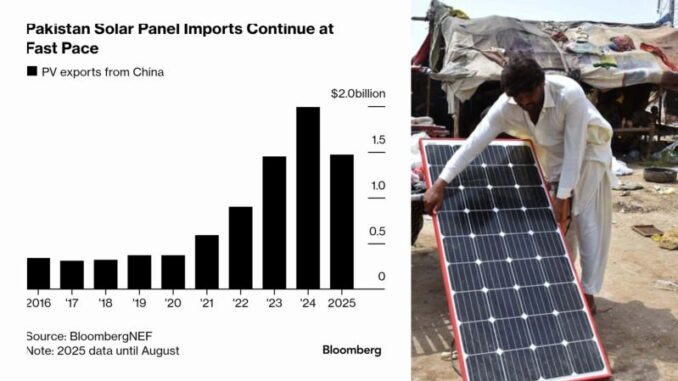
Bloomberg writes, the spread of rooftop solar among Pakistan’s citizens is testing the country’s ability to pay its energy debts.
The gov’t buys power from generators and sells it to consumers, using revenues to pay back creditors such as China. But it’s doing so at a loss, and collections are now starting to decline as families and businesses increasingly generate their own power.
Lawmakers are now turning to unpopular reforms to stem the tide. Panels purchases are now subject to levies. The initial proposal involved a 18% tax. It was halved after public backlash. Another option is to cut the rates paid to households selling surplus solar to the grid, an idea that was stalled by Prime Minister Shehbaz Sharif.
Both panel and battery imports from China are on the rise. Pakistan imported $1.5B worth of panels this year, becoming the third-biggest importer globally. Analysts also estimate the country has 25 GW of solar panels, installed without gov’t support, a significant boost to its grid’s modest 50 GW capacity. The nation also purchased about 1.25 GW of batteries in 2024. By 2030, that could increase to 8.75 GWhrs, increasing financial pressure on the grid, the analysts said.
The IMF has warned the Pakistan’s gov’t to retain power customers to ensure the viability of its energy sector. The nation signed its largest-ever restructuring this month, including opening new loans with 18 banks worth $4.2B in power sector debt.
“Pakistan didn’t plan its solar energy revolution, it just happened” said Khalid Waleed, at Sustainable Development Policy Institute. “We are stuck in a vicious cycle. We need to increase utilization of coal power plants or retire and repurpose them.”
Right now, the gov’t is buying solar power at a very high price, so it makes sense for customers to set up panels instead of relying on the grid, on the energy sector and the country’s privatization minister said in an interview.
Muhammad Ali, a member of the PM’s task force says, “Unless we revise our solar policy, this defection from the grid will continue.” That will further pressure Pakistan’s energy system that’s already dealing with a glut, he said.
Our Take 1: Good on Bloomberg for reporting on these developments. The Pakistan “solar miracle” is a favorite hobby horse of always-be-hyping solar advocates. Of course, as with so much in the renewables sector, the whole truth is far uglier than is often presented.
Our Take 2: System economics are the same regardless of locale. And the answer is always the same—off-grid decentralized and intermittent generation assets always rob the broader system of revenues required to survive. The result is the kind of pricing death spiral that Pakistan is experiencing.
Our Take 3: In the end, going all-in on intermittent renewables inevitably leads to capacity (and investment) 4x or 5x peak demand levels… compared to 1.2x for centralized systems serviced by dispatchable thermal generation.
Doug Sheridan – LinkedIn – we recommend following him.
Tax Burden in 2025?
Crude Oil, LNG, Jet Fuel price quote
ENB Top News
ENB
Energy Dashboard
ENB Podcast
ENB Substack







